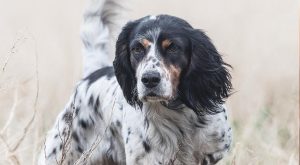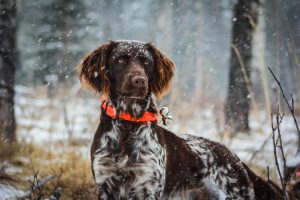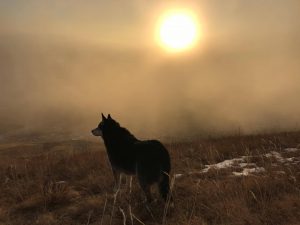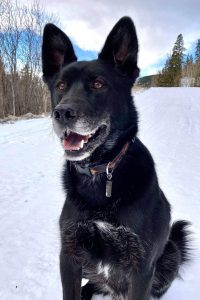In the end there were two contenders: the Griffon, and the Small Munsterlander. “The Small what…?” is the response I got a few times, even from my vet’s assistant. The Small Munsterlander, or Heidewachtel as we used to call them back home. My first dog was a Small Munsterlander. Neither of us knew what we were doing, but we both tried. Serendipity interfered when I found a breeder of Munsterlanders a mere twenty minute drive from where I live. They even had a few Dutch dogs in their kennel. A Dutch hunter and a two Dutch dogs travel half-way across the world to end up in the same place. It was preordained.
The Small Munsterlander is a breed that originated in Germany.Reports of dedicated breeders of dogs that fit the description go back as far as the mid 1800s. At the time no standard existed, and it wasn't until 1912 that a breed association was founded. Although purists proclaim that the bloodlines follow German huntings dogs back for hundreds of years, it is more than likely that some French Epagneul blood was mixed in at some point. The story is laid out in detail in Episode 4 of the Hunting Dog Confidential podcast. Well worth a listen!
Four Point Kennels turned out to be a pretty solid operation. They have been hunting and breeding Small Munsterlanders since 2013, sell puppies only to hunting households, and are active in the local chapter of the North American Versatile Hunting Dog Association. All their dogs came from great hunting lines. I provided them with a bit of a resume in my introductory email, and we agreed on a meet and greet. I stopped by their place coming back from a morning’s grouse hunting, the smell of which made me instantly likeable to each and every dog. Their kennels looked spacious and clean, all the dogs were friendly, active, happy, and eager to receive my pets and cuddles (because I smelled like grouse). On top of that Tanner and Toby proved to be pretty nice as well.
The next week I was back at their place and watched four dogs work on homing pigeons. We discussed litters. I handed over a down payment.
At that time, Toby and Tanner were still eagerly waiting to see if Lou’s artificial insemination had taken. Right now, Lou’s pups are three weeks old! She whelped eleven pups, six males and five females. We had indicated our interest in a male, so there are choices to be made. When they are a bit older we’ll go meet them and see if one (or more) of the pups pick us. Call me silly, but it happens. Aika, our German Hunting Terrier, was the only pup in the litter that showed interest in that strange guy visiting their snowy kennel near Hannover, and that was the one I brought home.
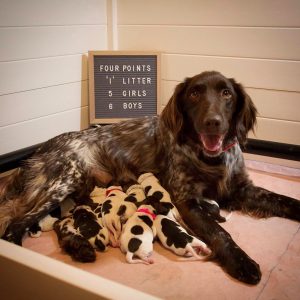 Until then we are just enjoying the photos and videos that Tanner and Toby put up on Instagram and Facebook. Go have a look: @fourpointkennels. They have another litter coming soon, so the next two months their feed will be full of adorable pups.
Until then we are just enjoying the photos and videos that Tanner and Toby put up on Instagram and Facebook. Go have a look: @fourpointkennels. They have another litter coming soon, so the next two months their feed will be full of adorable pups.
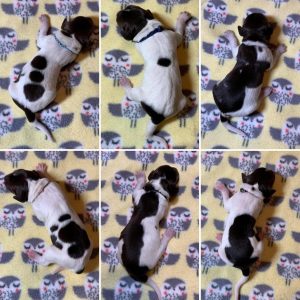
The six males: (top row) Inferno, I am Bulletproof, Ivan, (bottom row) Identity Theft, Iceman, Indiana Jones.
But seriously, how do you pick? I’m trying to not develop a bias just yet, based on their looks only. But I like Inferno! Or Ivan, as he is the biggest. The paw print patch on Identity Theft’s butt is cute, and Kyle’s kids have proclaimed him the favourite. In the end, Tanner and Toby’s opinion will play an important role as well, as they have the opportunity to observe the squirmy critters for a much longer period than we can. Which one shows more dominance, which one is more laid back? Is one of them more independent than the others perhaps? Who likes to cuddle? They probably all chase a pheasant wing when pulled away from them on a string. There is only so much you can try to approach objectively. In the end, the heart will have an important say. And perhaps there are one or two pups who think that the weird guy that is coming to visit (again) is really not so bad after all. I’ll stick a grouse wing in my pocket, to increase my odds.
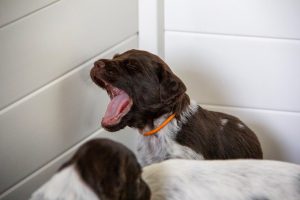
Ivan
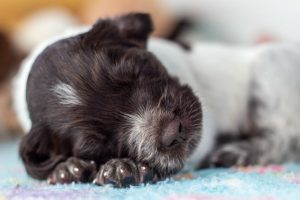 Cuteness overload
Cuteness overload
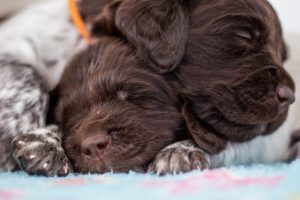
That looks like Ivan smothering one of his siblings
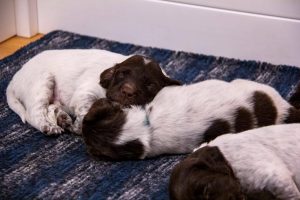
I’m Bulletproof sleeping on Inferno
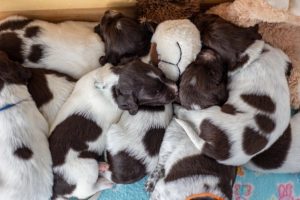
Hard to see where one ends and the other begins
To be continued…
FD
